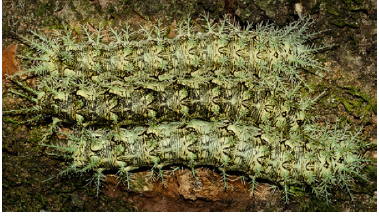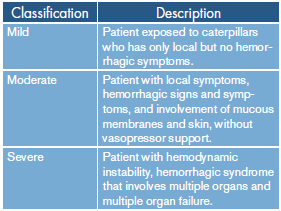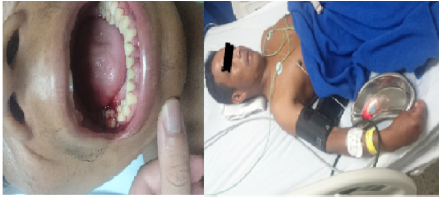INTRODUCTION
Lonomic accident or lepidopterism- erucism is understood as the disease caused by direct contact with caterpillars of the family Lonomia sp. Currently, there are about 26 variants of this species distributed throughout the Americas, where different denominations have been used to describe these larvae: fire caterpillars, churruscus (Colombia) or muchiras (southern Colombia and Ecuador). 1
Accidents and diseases caused by poisonous terrestrial animals, such as caterpillars, amphibians and myriapods, or aquatic animals, are rarely reported in Colombia, and there is little information on their diagnosis and management. Culturally speaking, it is known that most affected people belong to indigenous communities and are exposed due to their economic and social activities, sociocultural particularities, the scarce or lack of protection of the hands, feet and skin, and even by the use of Phyllobates sp. venom in hunting activities. 2
The caterpillars of the Saturniidae species (Figure 1) are characterized by pointed and branched spicules, bristles or hairs that contain a complex mixture of enzymes and toxins. 3 These substances are released into the skin after contact, causing activation of the kinin-kallikrein system and fibrinogenlytic enzymes that produce a wide arrange of signs and symptoms because of the alteration in the coagulation cascade involving factors VIII-XIII-X. 3,4 Authors have reported cases of caterpillar poisoning that start with multiple symptoms at the inoculation site and then progress to general symptoms. Initial symptoms include general malaise, headache and nausea, followed by hemorrhagic syndrome, which leads to multiple organ failure and even death. 5
Blood dyscrasia is closely correlated to the symptoms and is the most serious complication; it is usually established within the first 48 hours after contact. Moreover, hemorrhagic lesions may vary from ecchymotic lesions to episodes of massive and intraparenchymal bleeding. 7
The main treatment involves the use and administration of antilonomic serum, depending on the classification and description of symptoms in the patient (Table 1). The process that counteracts the mechanisms of the pathological lesion and reduces the symptomatology is currently known. 7-9
CASE PRESENTATION
A 41-year-old male patient from the Curipao indigenous ethnic group, residing in the municipality of Tame, Arauca (Colombia), with a history of chronic gastritis without pharmacological treatment and no other relevant condition, was admitted at a secondary healthcare center on September 26, 2016, with an apparent snakebite injury diagnosed in a primary healthcare center. The man reported that around 10:00 a.m. the day before, he left his home to carry out agricultural work and had contact with an animal (unidentified at first) in the back side of the right hand (Figure 2). He also reported the insertion of approximately 20 bristles into the skin that caused him intense localized pain, similar to stinging pain, with an intensity of 8/10 on a pain scale, which were removed a few minutes later with a sharp object (knife). After that, he expressed feeling irradiation of pain towards the elbow, sensation of paresthesia, pruritus, edema, redness and heat on the lesion site. He said that he applied a topical fungal cream 20 minutes after contact, improving the symptoms, pain and redness; however, edema of the hand persisted (Figure 2).
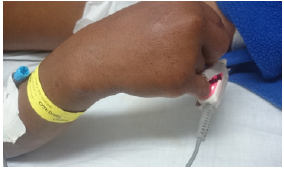
Source: Document obtained during the study.
Figure 2 Primary site of contact with caterpillar Lonomia sp.
The man manifested the onset of global headache and hematemesis -approximately 30 episodes during the day- and burning pain in the epigastric region without irradiation, and generalized arthralgia. The following day, he decided to seek medical help at the nearest center (primary healthcare center), where he reported persistence of symptoms and appearance of bleeding gums. The medical assessment resulted in a diagnostic impression of snakebite accident, and management with omeprazole and intravenous fluid therapy was initiated. Laboratory reports indicated 13 000 leukocytes, 86% neutrophilia, 14% lymphocytes, and prothrombin time and partial thromboplastin time >1 minute; no platelet count was available.
He was referred to a secondary healthcare center, where he was admitted for evaluation and management by an internist. The vital signs on admission were: heart rate: 87 /min, respiratory rate: 19/min, blood pressure: 146/83 mmhg, oxygen saturation: 98%, and fraction of inspired oxygen: 0.21. On initial physical examination, slight skin paleness was observed, along with active bleeding in the gums, especially in the dental fracture of the right first molar (Figure 3); cardiopulmonary aspects without alterations; soft abdomen with pain in epigastrium region; and right upper limb with edema located in the dorsum, erythematous punctiform lesions, without redness or heat, and mild pain on palpation. No strength deficiencies were observed during the neurological examination and sensitivity was preserved.
Finally, two episodes of hematemesis occurred during hospitalization, for which hematology tests and blood chemistry were requested. Table 2 presents the results of the laboratory tests carried out on admission, revealing an increase in kidney function and alteration of liver function; deterioration of leukocyte and platelet function is also evident.
Table 2 Lab test reports obtained during clinical evolution.
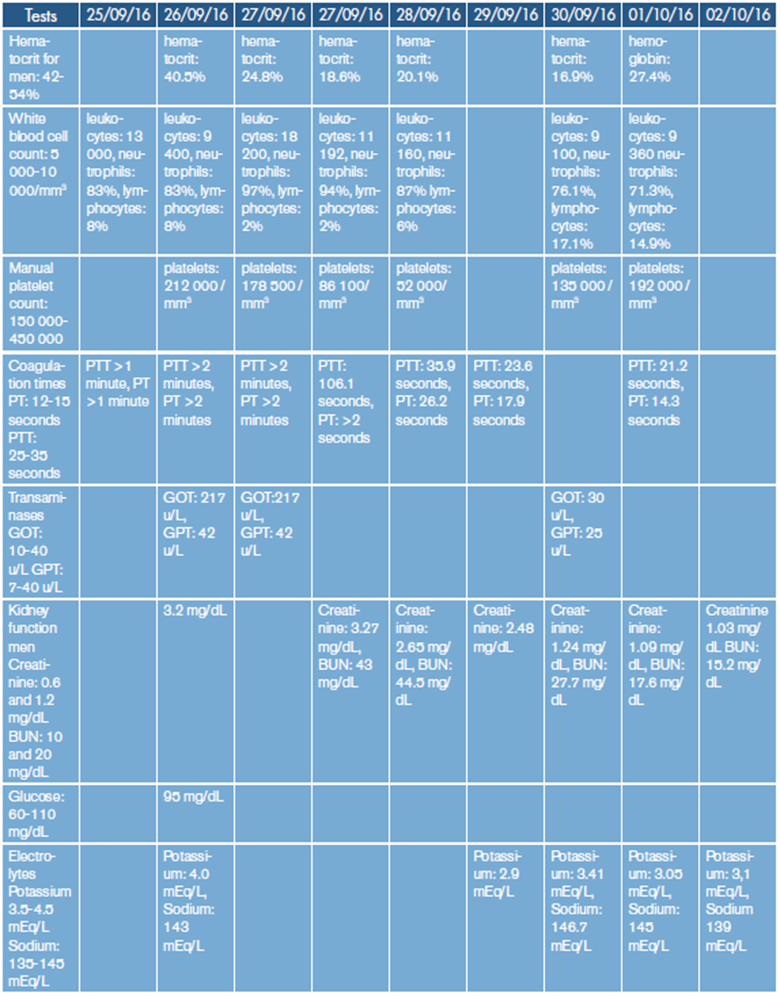
PTT: thromboplastin time; PT: prothrombin time; GOT: glutamic-oxalacetic transaminase; GPT: glutamic-pyruvic transaminase; BUN: blood urea nitrogen.
Source: Own elaboration.
In order to assess and control hemodynamics, the patient was taken to intermediate care and received treatment with fluid therapy of 0.9% saline solution, 300mg hydrocortisone single dose, 6 vials of antiophidic serum IV, antibiotic management with third generation cephalosporins (ceftriaxone) 1g every 12 hours, 600mg lincosamides (clindamycin) every 6 hours, 1 vial of tranexamic acid every 8 hours, 1mg vitamin k every day, 40mg omeprazole every 12 hours, 20mg simple hyoscine and 10mg metoclopramide every 8 hours. Control lab tests were subsequently requested based on his clinical evolution and according to the need.
Medications were not applied intramuscularly due to the risk of hematomas as an adverse event. After initiating pharmacological administration and upon observation, it was concluded that there were no hemodynamic alterations, no need for vasopressor support, no cardiac frequency alterations, oxygen saturation of 98%, and fraction of inspired oxygen of 0.21. Regarding the neurological condition, there were no focalizations or new episodes of hematemesis, no increase in hand edema, but there was persistence of pain in the epigastrium region and bleeding in the gums. Management with transfusion of five units of frozen plasma (Table 2) was initiated and a chest X-ray was performed to establish pulmonary involvement, which did not show relevant acute lesions.
Subsequently, a new physical examination was performed, leading to the impression of lonomic accident based on the recognition of the animal by the patient from graphic material, thus confirming suspicion of diagnosis of poisoning by Lonomia sp. Therefore, the Departmental Health Secretariat and the Bogotá Health Secretariat were immediately notified; they confirmed the availability of five vials of antilonomic serum in a tertiary referral hospital to where he was transferred for comprehensive management. He was admitted to this hospital with a diagnostic impression of septic shock versus hypovolemic, lonomic accident, upper digestive tract bleeding and normochromic microcytic anemia.
The patient was immediately assessed by the internal medicine service, which indicated the need for intravenous application of antilonomic serum and subsequent control tests for follow-up. During the application of the five vials of serum, no adverse events or reactions were observed; additionally, hemodynamic control did not present deterioration, neurological state was preserved and bleeding in the gums persisted.
With the passage of time, the bleeding in the gums resolved and control lab tests showed improvement and slight prolongation of coagulation times; there was also a decrease in neutrophilia without hemodynamic decompensation, but thrombocytopenia and a decrease in serum creatinine persisted. During hospitalization, a complete ultrasound of the abdomen was performed, showing liver with some degree of parenchymal destructuring of micro nodular aspect and findings compatible with diffuse liver parenchyma lesion, possible alcoholic hepatic cirrhosis, and bilateral pleural effusion. Modification of parenteral fluids was indicated considering possible signs of overload, as well as transfusion of two units of red blood cells.
During the night, a new transfusion of red blood cells was made. However, the patient showed no signs of hemodynamic instability and his neurological state was preserved. Correction of acute anemia, preserved kidney function, correction of hypokalemia, preserved coagulation times and corrected thrombocytopenia were observed; there was no evidence of bleeding in the gums. He was finally discharged to continue medical treatment and care on an outpatient basis.
DISCUSSION
Cases associated with poisonous contact with caterpillars that do not cause hemorrhagic syndrome have been described, therefore, not all poisoning mechanisms are the same and different enzymatic mechanisms may be involved. 10 Some species only cause acute kidney failure as the main complication, but this could also be caused by ischemia (Table 1). 11
Despite the lack of case reports, this type of cases has been reported in Brazil, Venezuela, Argentina and French Guiana in Latin America. According to statistics, between 1989 and 2005, 354 cases were reported in Brazil, with a lethality that dropped from 20% in 1995 to 15% in 1998, being intracranial bleeding the cause of death in 50% of cases. 12
In Colombia, the incidence of lonomic accidents and knowledge of this pathology is low, making epidemiological notification difficult. According to the Colombian Toxicological Research, Management and Information Center, between 2006 and 2010, 68 cases of lepidopteran accidents occurred due to spontaneous and passive reporting, being the sixth cause of incidence of accidents by poisonous animals, with a relative frequency of 4% (Figure 4). 13 In 2000, the first cases of hemorrhagic syndrome secondary to Lonomia sp were reported; they occurred in the departments of Guainia, Valle del Cauca, Boyacá, Caldas, Antioquia, Cundinamarca and Meta, each case with especial characteristics concerning their evolution (Figure 5). 14
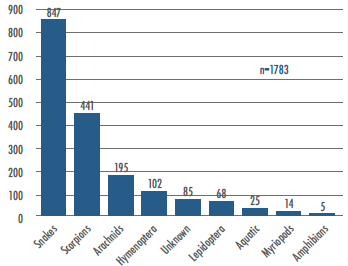
Source: Elaboration based on Rodriguez-Vargas et al. (13).
Figure 4 Frequency of accidents caused by poisonous animals in Colombia, 2006-2010.
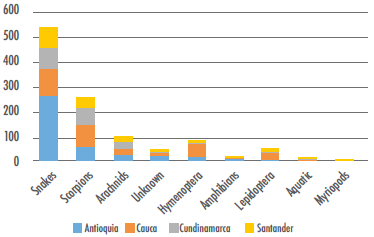
Source: Elaboration based on Rodriguez-Vargas et al. (13).
Figure 5 Frequency of accidental poisoning by department in Colombia. 2006-2010.
It should be noted that there is currently evidence of under-reporting, since it is impossible to notify a lonomic accident that was previously reported as ophidic, as in this case. In addition, this could be correlated with the lack of knowledge of health personnel to identify cases of lonomism. This last aspect was evident in the present case as it was initially treated as an ophidic accident and there were delays in the care process; consequently, the management of the patient was only adequate until he was referred to a high complexity health center.
In addition, it should be noted that the highly specialized professionals who attended the present case had basic notions and some degree of expertise in this accident and subsequent pathological manifestation. Basic knowledge for proper management is vital in correlations involving poor performance or intervention and the development of a pathology associated with injury to multiple vital organs, and even death.
CONCLUSIONS
The use of antilonomic serum therapy led to complete recovery 17 hours after initiating the treatment, without the presence of associated complications and coincides with the management described in other reports. 14 However, it is important to emphasize that management with intrahospital therapy allowed for a positive evolution of the patient and early diagnosis.
One of the disagreements between the system and health care lies in the lack of knowledge of the pathology and the lack of availability of fresh frozen plasma, devices for transfusion of red blood cells and antilonomic serum. For this reason, it was necessary to refer the patient to hospitals of all tiers of care, affecting his clinical picture and putting at risk his vital organs. It is important to mention that the latter two reasons are the most common causes of worsening. 14
It is necessary to identify the medical centers and professionals that are in the areas where this species lives in order to provide training according to the socio-demographic context and to provide resources that allow them to have the necessary inputs to improve medical interventions and obtain better health outcomes.













